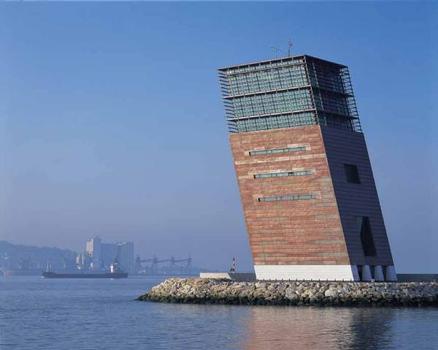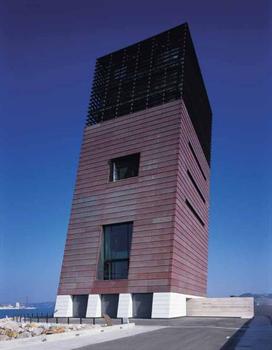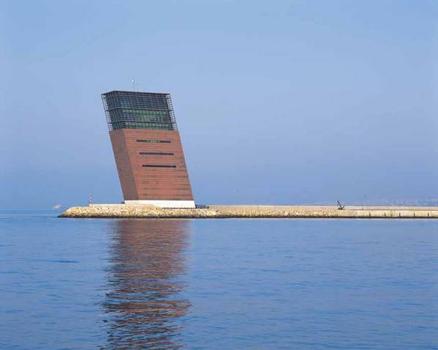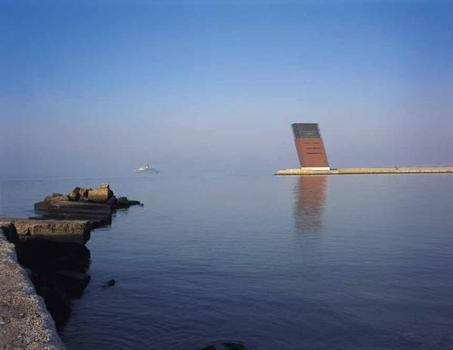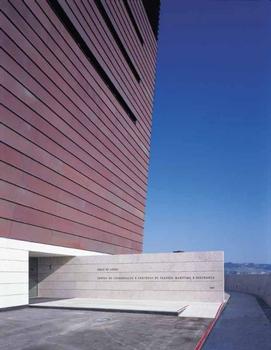General Information
| Other name(s): | Centro de Coordenacáo e Controlo de Tráfego Maritimo e Seguranca |
|---|---|
| Completion: | 2001 |
| Status: | in use |
Project Type
| Function / usage: |
Port control tower |
|---|
Location
Technical Information
Dimensions
| height | 38 m | |
| number of floors (above ground) | 9 | |
| dimensions at base | 13 m x 19 m |
Case Studies and Applied Products
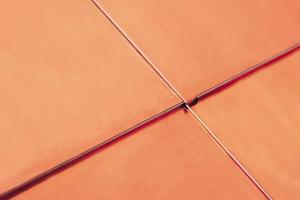
TECU® Classic
TECU® Classic is the product name for traditional bright rolled TECU® sheets and TECU® strips.
[more]Chronology
| 9 May 2003 | First Prize, TECU ® Architecture Award. |
|---|
Notes
The "Black Coast" is the name the English gave the western edge of Europe before the Portuguese built the first lighthouses in the mid 18th century. Today, sailors are confronted with a very different scene: Portugal now operates a very modern coastal control centre - the only one of its kind in Europe. The idea for this "active" lighthouse was first introduced in a design competition. The winning design, submitted by Portuguese architect Gonçalo Sousa Byrne, was brought to life this year with the completion of construction. The control tower, leaning slightly out over the water, stands out against Lisbon's city skyline with its impressive and aesthetic cladding of shimmering red brand-name TECU®-Classic copper sheets.
Gonçalo Sousa Byrne was born in Alcobaca, Portugal in 1941. After completing his studies at the University of the Arts in Lisbon and receiving his diploma in 1968, he worked for Raul Choráo Ramalho and later in the studio of Nuno Teotónio Pereira und Nuno Portas until 1975. Together with Portas, he carried out studies at the Portuguese Research Institute of Building Engineers. Byrne's works are characterized by his efforts at rationalization and formal and graphic strictness. Using utmost care, he connects the morphology of the landscape with his constructive models.
The architecture of Gonçalo Sousa Byrnes is defined by unusually high quality. His most important works include the Arraiolos branch bank (1998), the redesign of docks in Lagos (1991) and the building for the electrotechnology faculty at the Technical University of Coimbra (1992). Gonçalo Sousa Byrne has become very well-known internationally due to his numerous successes in design competitions and through visiting professorships and exhibitions.
The Portuguese, most well-known in the 16th century as discoverers of the New World, have been involved with their own history since the Carnation Revolution of 1974, but have at the same time opened up to the European Economic Community. Lisbon cleverly used the 1998 Expo, held in the Portuguese capital, as an impulse in their own urban upswing. The national costal control centre project is subsidized by funds from the European Union. Located near the impressive Centro Cultural de Bélem building that dramatically shapes Lisbon's cultural scene, the center's first building is now open to visitors. Of the five architects invited to participate in the design competition, Gonçalo Sousa Byrne's design was awarded first prize and has now been constructed.
At the tip of an artificially created cape, a 38 meter high solitary structure rises up, projecting out over the Rio Tejo. Higher up, the appearance of the varied facade softens the massive look of the building's strictly symmetrical shape. A one-storey foundation of light-colored stone "anchors" the building in the ground. A storey-high flat wall defines the main entrance. The shaft of the new building is decked in a cladding system consisting of TECU®-Classic copper sheets in horizontal double seam cladding. Its shiny surface has already formed an oxide layer. This protective layer stabilizes the copper surface, protecting it against exposure to the atmosphere and lending the material its unmistakable appeal and extraordinary durability. On vertical or sheltered surfaces, the oxide layer develops into an anthracite-brown hue with a matt shine. On inclined surfaces, the protective layer continues to change in color. The light green shimmer gradually develops into copper's familiar patina green, creating a soft, continually varying play of color on the vertical and inclined facades of the harbor control tower.
The outer surface of the building's three-storey crown is designed as a pure glass facade behind copper lamellas. To construct such a special structure that is technically correct and aesthetically pleasing, the TECU® Technical Consulting Center at KME can assist you on request with planning, preparing tender documentation and advising builders on site.
The interior of the building is composed of a nine-storey central entry hall from which the groups of rooms surrounding it are accessed. In addition to offices, there are two simulators and a number of seminar rooms available for employee training. In contrast to classical lighthouses that only provide orientation, this new generation of "active" lighthouses takes on all the functions of monitoring and controlling shipping traffic. Since all vessels are required to register in the control area they are currently in and are subsequently monitored constantly by radar, shipping traffic can be coordinated in the best possible manner. The tower's VTS system (Vessel Traffic Service) is now ready to be launched internationally. The coastal control centre also provides central control of all necessary actions in emergency situations.
With the inauguration of the coastal control tower on July 16, 2001, the Cultural Capital of Europe 2001, a city built across seven hills, welcomed another shining architectural achievement to its skyline - a reminder of the great Portuguese traditions in sailing and exploration.
Participants
Relevant Web Sites
There currently are no relevant websites listed.
- About this
data sheet - Structure-ID
20008999 - Published on:
13/04/2003 - Last updated on:
21/04/2016

